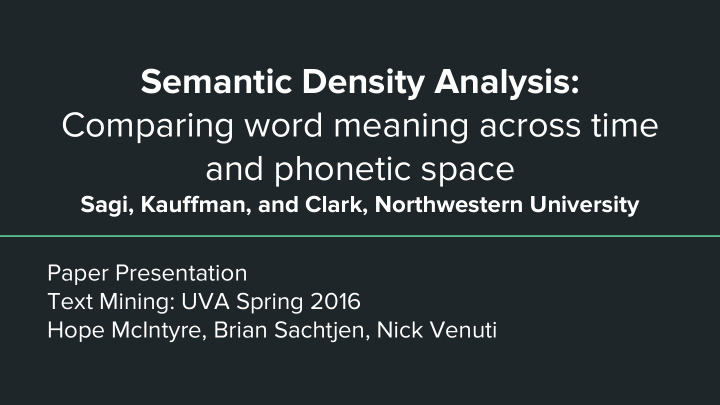



Semantic Density Analysis: Comparing word meaning across time and phonetic space Sagi, Kauffman, and Clark, Northwestern University Paper Presentation Text Mining: UVA Spring 2016 Hope McIntyre, Brian Sachtjen, Nick Venuti
Research Goal It was a beautiful day in the neighborhood. The dog ran toward the fence. I was walking the dog in the neighborhood. It started raining. My friend passed by me. I said, “What up, dog?” He replied, “Not much.” ... dog ... Doc1 1 Doc2 1 Doc3 1
Challenges in Understanding Word Usage ● Word meanings have the tendency to vary Multiple definitions ○ ○ Different cultural norms Temporal shifts ○ ● Limited approaches to quantifying context Lack of ordering in bag of words approach ○ ○ Typically produce document level metrics (e.g. topical analysis) Assumes word independence ○ ○ Gives equal value for all occurrences of a word Some words not present in manually annotated Lexicon ○
General Hypothesis for Quantifying Meaning ● The definition of a word can be gleaned from the words around it ● Word meanings can be compared by measuring the similarity of a word’s contexts ● A greater context similarity = a smaller range in that word’s meanings ● Compute context vectors to measure context similarity
Sagi, Kauffman, and Clark’s Proposed Solution 1) Word Vectors: Develop co-occurrence matrix & reduce through Singular Value Decomposition 2) Context Vectors: Create context vectors based on value from co-occurrence matrix and words within k sized window 3) Semantic Density: Calculate average cosine similarities of context vectors It was a beautiful day in the neighborhood. The dog ran toward the fence. For Example: Target Word: I was walking the dog in the neighborhood. It started raining. “dog” Target Window: 4 My friend passed by me. I said, “What up, dog?” He replied, “Not much.”
Produce Word Vectors It was a beautiful day in the neighborhood. The dog ran toward the fence. I was walking the dog in the neighborhood. It started raining. My friend passed by me. I said, “What up, dog?” He replied, “Not much.”
Produce Context Vectors It was a beautiful day in the neighborhood. The dog ran toward the fence. I was walking the dog in the neighborhood. It started raining. My friend passed by me. I said, “What up, dog?” He replied, “Not much.”
Calculate Target Word Semantic Density ● Density = Semantic variation within the set of individual occurrences of a given word, a more cohesive term has a higher density (word usage is “packed” in hyper-space) ● Measured by average cosine similarity “dog” c 3 c 2 c 1
Empirical Analysis ● Sagi et al. tested context vector methodology on Helsinki Corpus by investigating semantic shifts known from linguistic research ● Analyzed cases of semantic broadening, narrowing, and degeneration ● Ex. “Do” ○ Old English, used solely as a verb with a causative and habitual sense (e.g. “do you no harm”) Later English, functional role, nearly devoid of meaning (e.g. “Do you know him?”) ○
Limitations & Further Applications ● Target words need to be known or defined by experts ● High computational complexity ● Only useful for relative comparisons ● Still haven’t resolved all of the ambiguity of natural language ○ Word meaning depends on more than simple patterns of co-occurrence ● Further Applications: ○ Assist linguists in identifying new shifts in language trends ○ Predicting tendencies towards peace or violence in religious groups ○ Identify differences in word usage in American Presidential addresses ○ Cluster with these measurements to distinguish homonyms
Questions?
Recommend
More recommend